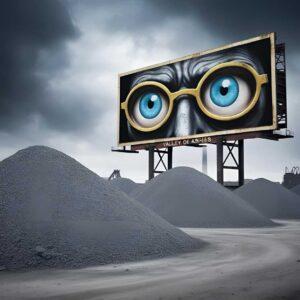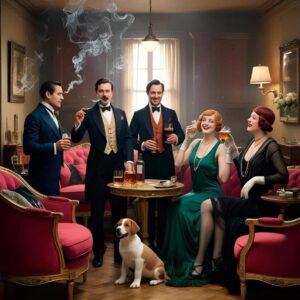What harsh truths lie beneath the glittering facade of an era of excess, and what occurs when stark social divides are breached?
Following the introduction to Long Island’s wealthy enclaves in Chapter 1, F. Scott Fitzgerald’s The Great Gatsby dramatically shifts tone and setting in Chapter 2.
Narrator Nick Carraway is unwillingly pulled into the desolate “valley of ashes” and thrust into a sordid, chaotic apartment party in New York City, exposing the era’s grim underbelly and the consequences of Tom Buchanan’s transgressions.
These unsettling excursions reveal the radical class divides and moral compromises festering beneath the surface of the Jazz Age.
First, find a concise summary recapping Chapter 2’s key events chronologically. Then, our analysis argues Fitzgerald uses these contrasting settings and their inhabitants to unmask the pervasive moral decay, expose the brutal realities of class desperation, and critique the hollowness of Jazz Age materialism, all under the ambiguous gaze of Doctor T.J. Eckleburg’s eyes.
(For context on Nick’s arrival and initial impressions of Long Island society, see the Chapter 1 Summary & Analysis.)
The Great Gatsby Chapter 2 Summary of Events
Chapter 2 shifts dramatically from Long Island’s estates, pulling Nick into new, unsettling territories and Tom Buchanan’s sordid secret life, culminating in violence.

Descent into the Wasteland: The Valley of Ashes
Nick describes the train journey from West Egg to New York City, which traverses a desolate industrial area halfway between the opulent Eggs and the city, known as the “valley of ashes.” He vividly portrays it as a “fantastic farm where ashes grow like wheat,” populated by “ash-grey men” who toil in the “powdery air.”
Looming over this grim landscape from a massive, decaying billboard are the “blue and gigantic” eyes of Doctor T. J. Eckleburg, wearing “enormous yellow spectacles,” which “brood on over the solemn dumping ground.”
An Unwilling Detour: Wilson’s Garage
One day, while riding the train with Tom Buchanan, Tom, likely fueled by lunchtime drinks and dismissing Nick’s plans, whose determination Nick notes as “bordering on violence,” forcefully insists Nick get off with him at a stop in the valley of ashes.
Tom leads Nick to Wilson’s Garage, situated on the edge of this wasteland. Here, Nick meets George Wilson, Myrtle’s husband, whom he describes as a “blond, spiritless man, anaemic,” and physically covered in the pervasive ash. Wilson hopes to question Tom about a car Tom had mentioned as a potential sale, but Tom dismisses him with vague promises.
Myrtle Wilson: A Vital Spark in the Grey
Myrtle Wilson enters, her “perceptible vitality” and stout, sensuous figure contrasting sharply with her husband’s listlessness. She completely ignores George, walking through him “as if he were a ghost.”
While George obediently fetches chairs at her command, Tom quickly and covertly arranges for Myrtle to meet him in the city, instructing her to “Get on the next train.” Later, Tom reveals to Nick that Wilson is oblivious to the affair, believing Myrtle visits her sister in New York, and contemptuously adds, “He’s so dumb he doesn’t know he’s alive.”
A Taste of the City: Purchases and Pretensions
Myrtle travels to New York on a separate train and meets Tom and Nick. She immediately insists on several purchases, including celebrity gossip magazines (“Town Tattle,” a movie magazine), cold cream, perfume, and an Airedale-mix puppy from a street vendor, items reflecting her materialistic aspirations.
In the station’s solemn echoing drive, she deliberately lets four taxis pass before selecting a new one, lavender-colored with grey upholstery, to take them uptown. Tom then pressures a reluctant Nick to accompany them to the Morningside Heights apartment he maintains for his affair.
Chaos in the Apartment: A Vulgar Gathering
Nick describes the small, top-floor apartment as stifling and overcrowded with “tapestried furniture entirely too large,” depicting scenes of Versailles, an ironic contrast to its squalid reality. Nick notes a dog biscuit “decomposing apathetically” in a saucer of milk.
He states he gets drunk for only the second time in his life, and his memories of the afternoon consequently become hazy.
Myrtle changes from her dark blue dress into an “elaborate afternoon dress of cream colored chiffon” and adopts an “impressive hauteur,” her personality transforming with her attire. Guests arrive: Myrtle’s sister, Catherine (described as worldly, with a “solid sticky bob of red hair” and noisy bracelets), and a couple from downstairs, Mr. McKee (a pale, “feminine” photographer involved in the “artistic game”) and his “shrill” wife.
Gossip, Lies, and Drunken Revelations
Fueled by Tom’s whiskey, the conversation becomes loud and superficial. Catherine shares rumors about Gatsby, suggesting he’s a relative of Kaiser Wilhelm and implying his wealth is illicitly obtained (“That’s where all his money comes from”). She also repeats Tom’s lie that Daisy is Catholic, which supposedly prevents Tom from divorcing her to marry Myrtle.
Myrtle recounts how she met Tom on a train, drawn by his expensive suit and patent leather shoes, to justify her impulsive decision with the fatalistic thought, “You can’t live forever.”
Violence Erupts: The Party’s Brutal End
As Myrtle becomes more drunk and boisterous, she defiantly chants Daisy’s name: “Daisy! Daisy! Daisy!” Tom, after warning her to stop, strikes her across the face with a “short deft movement” of his open hand, breaking her nose. The party descends into chaos, amidst sounds of pain, arguments, and the sight of “bloody towels.”
Nick’s Hazy Departure
Disgusted and disoriented by the vulgarity and violence, Nick leaves with Mr. McKee. His memory of their departure is fragmented and surreal, including an image of McKee in his underwear holding a portfolio and a disconnected list of words like “‘Beauty and the Beast … Loneliness … Old Grocery Horse … Brook’n Bridge ….'” The chapter concludes with Nick alone and cold at Penn Station, waiting for the 4 a.m. train back to West Egg.

Chapter 2 Analysis: The Valley of Ashes and a Vulgar Party – Fitzgerald’s Unmasking of Jazz Age Decay and Class Desperation
Beyond its harsh plot, Chapter 2 is Fitzgerald’s scathing early critique of the era. He uses the symbolic landscapes of the Valley of Ashes and the squalid city apartment to expose the moral desolation and desperate illusions festering beneath the Jazz Age’s glittering surface.
The Valley of Ashes: Landscape of Moral & Industrial Consequences
Fitzgerald establishes the Valley of Ashes not merely as a poor district, but as a potent symbol of industrial capitalism’s desolate refuse and the moral wasteland it cultivates. His vivid description of a “fantastic farm where ashes grow like wheat” and “ash-grey men” who “move dimly and already crumbling” creates a palpable atmosphere of suffocation and decay.
This grey expanse, the grim underbelly of the nearby wealthy Eggs, physically manifests the forgotten consequences of unchecked materialism, trapping inhabitants like George Wilson in its spiritual and economic dust.
Eckleburg’s Gaze: Faded Judgment in a Godless World?
The Eyes of Doctor T. J. Eckleburg, looming over the Valley from a decaying billboard, are a complicated and unsettling symbol. These “blue and gigantic” eyes behind “yellow spectacles” perpetually “brood” over the desolation.
As a commercial remnant, they suggest a world where commerce has supplanted divine oversight, yet even this commercial gaze is faded and neglected. Their persistent watchfulness implies judgment, but their decaying state hints that any moral vigilance is hollow or absent, reflecting a society losing its compass. They become an ambiguous, perhaps indifferent, witness to the moral decay below.
Encounters in the Dust: Character as Embodiment of Class & Despair
The garage scene exposes raw class dynamics and desperation. George Wilson, “spiritless” and “veiled in ash dust,” embodies the defeated working class, his hope for a car deal casually manipulated by Tom’s display of power.
Myrtle, in contrast, erupts with a “perceptible vitality,” a desperate, almost aggressive energy fueling her attempts to escape her bleak existence through Tom. Her complete dismissal of George, striding through him “as if he were a ghost”, and her immediate subservience to Tom’s summons for their city rendezvous reveal her motivations with brutal clarity.
Tom’s condescending remark about Wilson, “He’s so dumb he doesn’t know he’s alive,” delivered after ensuring Wilson’s ignorance of the affair, underscores his callous class arrogance and cruel exploitation.
Performing Status: The Apartment’s Hollow Stage & Myrtle’s Illusions
The Morningside Heights apartment is a tawdry, cramped stage for Myrtle’s desperate performance of imagined sophistication. The “tapestried furniture entirely too large” depicting scenes of Versailles, ironically highlights the artificiality and ill-fitting nature of her aspirations.
Her transformation upon donning the “elaborate afternoon dress of cream colored chiffon,” adopting an “impressive hauteur,” is a conscious effort to mimic the wealthy women she envies. The gossip magazines and the quickly neglected puppy, its biscuit left “decomposing pathetically”, are props in this performance, symbolizing her materialistic desires and perhaps foreshadowing the disposable nature of Tom’s affection for her.
The guests, Catherine and the McKees, mirror this superficiality; Catherine peddles gossip, while Mr. McKee, the pale photographer involved in the “artistic game,” almost overtly angles for an introduction to Tom’s wealthy Long Island connections, flattering Tom in hopes of professional advancement.
Violence Cracks the Facade: Tom’s Brutality & Its Implications
When Myrtle defiantly chants Daisy’s name, Tom’s brutal act of breaking her nose shatters the party’s thin veneer of raucous conviviality. This shocking act of physical aggression confirms the violent potential hinted at by Daisy’s earlier lament about Tom’s “brute” strength in Chapter 1 and Nick’s observation of Tom’s forcefulness.
His “short deft movement” is not impulsive rage but a cold, calculated assertion of his power and class dominance, a reminder to Myrtle of her subordinate position and his intolerance for her overstepping social boundaries by daring to utter his wife’s name in this illicit context.
The “bloody towels” and abrupt end to the party expose the raw power dynamics and violent undercurrents festering beneath the affair’s surface.
Nick’s Compromised Perspective: Drunkenness, Complicity, and Disgust
Nick’s role as narrator becomes significantly complicated in this chapter by his acknowledged intoxication; he states, “I have been drunk just twice in my life, and the second time was that afternoon.”
Tom deliberately involves Nick throughout, forcing him into the role of witness, perhaps seeking passive approval or simply indifferent to Nick’s discomfort. While expressing disgust at the vulgarity and violence, Nick’s continued presence, however reluctant, implies a degree of passive complicity or at least a voyeuristic fascination.
His departure with Mr. McKee descends into a haze. His fractured memory retains specific, unsettling fragments: noting McKee’s “feminine” aspect while earlier wiping shaving lather from his face, McKee’s forward lunch invitation, the sharp elevator operator, and the final surreal image of McKee in his underwear holding a portfolio alongside nonsensical words (“‘Beauty and the Beast … Loneliness…’”).
These strange details vividly convey Nick’s disorientation and the moral ambiguity of the evening, reflecting the difficulty of remaining truly “within and without, simultaneously enchanted and repelled by the inexhaustible variety of life” when immersed in such raw behavior.
Conclusion: Chapter 2: Unmasking the Jazz Age’s Underbelly
Chapter 2 masterfully juxtaposes the industrial desolation of the Valley of Ashes with the moral squalor of the Manhattan apartment party.
Through these harsh settings and the desperate actions of characters like Myrtle Wilson, Fitzgerald unmasks the rot festering beneath the Jazz Age’s glittering surface, exposing stark class realities, hollow materialism, and simmering violence.
Overseen by the enigmatic eyes of Doctor T. J. Eckleburg, this raw portrayal establishes the novel’s critical lens and the troubled, morally compromised backdrop against which Jay Gatsby’s extraordinary dream will unfold and ultimately be tested, a journey explored further in our Chapter 3 Summary & Analysis.
For a broader understanding of the novel’s intricate plot, visit the complete The Great Gatsby summary.
A Note on Page Numbers & Edition:
Just as the Eyes of Doctor T. J. Eckleburg brood over the shifting valley of ashes, grounding our summary and analysis requires a specific textual foundation. We meticulously sourced textual references for this summary and analysis from The Great Gatsby, Scribner 2020 Paperback edition (Publication Date: September 1, 2020), ISBN-13: 978-1982149482. Consulting different editions can reveal subtle textual shifts, much like the changing light over the wasteland depicted in this chapter.
